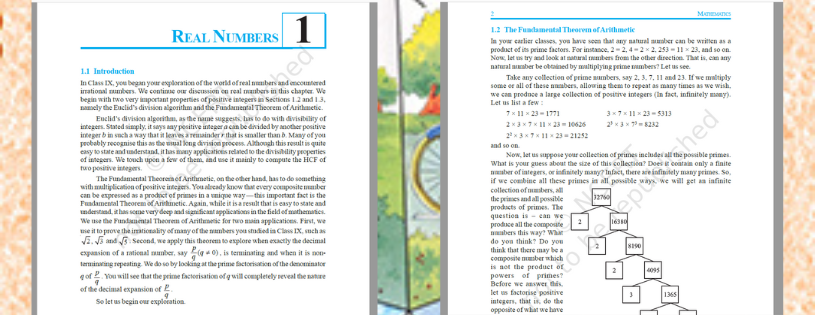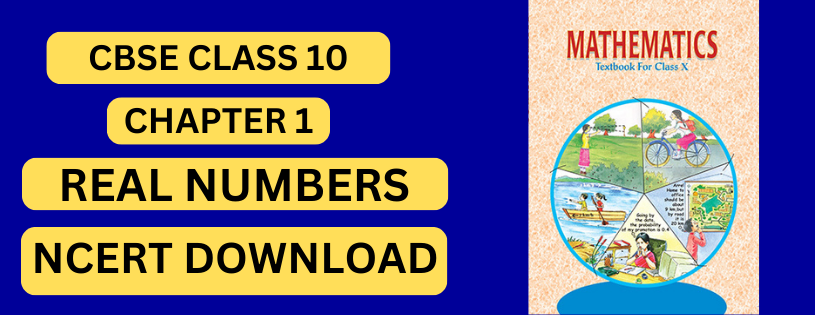In the fascinating realm of mathematics, the study of real numbers serves as the cornerstone for a myriad of mathematical concepts and applications. As we embark on Chapter 1 of the CBSE Class 10 Mathematics curriculum, we delve into the world of "Real Numbers," a fundamental and integral part of mathematical understanding.
Class 10 Mathematics (CBSE NCERT) – Chapter 1 Real Numbers
Real numbers encompass rational and irrational numbers, each holding unique properties that contribute to the vast tapestry of mathematical knowledge. This chapter unfolds with an exploration of rational numbers, offering insights into their properties, operations, and applications.
Understanding Real Numbers:
Inclusivity of Real Numbers:
- Real numbers encompass rational and irrational numbers, creating a comprehensive set that includes integers, fractions, decimals, and roots.
Representation on the Number Line:
- The number line is a visual tool that illustrates the continuum of real numbers, showcasing their order and relationships.
Properties of Real Numbers:
Closure Property:
- The sum, product, or difference of any two real numbers is also a real number, showcasing the closure property.
Commutative and Associative Properties:
- Real numbers follow the commutative and associative properties for addition and multiplication, providing consistency in mathematical operations.
Identity and Inverse Elements:
- Every real number has an additive identity (0) and a multiplicative identity (1). Additionally, every real number has an additive inverse and a multiplicative inverse, except for zero.
Exploring Irrational Numbers:
Nature of Irrational Numbers:
- Irrational numbers, such as the square root of 2, cannot be expressed as fractions. Their decimal expansions are non-terminating and non-repeating.
Pythagorean Theorem:
- The Pythagorean Theorem is a classic example of the significance of irrational numbers in geometry, where the length of the hypotenuse is expressed as the square root of the sum of the squares of the other two sides.
.webp)

Download Mathematics notes
Here, students are introduced to several important concepts that will be useful for those who wish to pursue mathematics
CBSE Class 10 NCERT Mathematics Topics for a Strong Foundation (NCERT DOWNLOAD)
CBSE Class 10 Board Exam Sample Paper

Download Question Bank
[Previous Year Question Solution Maths Download Button]
[Previous Year Question Solution Science Download Button
CBSE Class 10th Downloadable Resources:
Being in CBSE class 10th and considering the board examinations you must be needing resources to excel in your examinations. At TestprepKart we take great pride in providing CBSE class 10th all study resources in downloadable form for you to keep you going.
Below is the list of all CBSE class 10th Downloads available on TestprepKart for both Indian and NRI students preparing for CBSE class 10th in UAE, Oman, Qatar, Kuwait & Bahrain.
FAQ
Q1 What are Real Numbers?
Ans: Real numbers include all rational and irrational numbers. They can be positive, negative, or zero. Examples include integers, fractions, decimals, and square roots.
Q2 How do I differentiate between Rational and Irrational Numbers?
Ans: Rational numbers can be expressed as fractions, where the numerator and denominator are integers. Irrational numbers, on the other hand, cannot be expressed as fractions and have non-terminating, non-repeating decimals.
Q3 What is the Fundamental Theorem of Arithmetic?
Ans: The Fundamental Theorem of Arithmetic states that every composite number can be expressed uniquely as a product of prime numbers, up to the order of the factors
Q4 How do I find the HCF (Highest Common Factor) and LCM (Least Common Multiple) of two or more numbers?
Ans: To find the HCF, list the prime factors of each number and multiply the common factors. For LCM, list the prime factors and multiply each factor the greatest number of times it occurs in any of the numbers.
Q5 What is the Euclidean Algorithm?
Ans: The Euclidean Algorithm is a method to find the HCF of two numbers. It involves successive division using Euclid's Division Lemma until the remainder becomes zero. The divisor at this point is the HCF.


Post a Comment